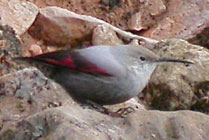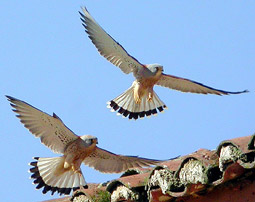 |
Spain: birds and birdwatching - part 1
by John Muddeman
Birds in Spain
In simple terms, the birds in Spain are diverse and still relatively abundant. This is due to a combination of factors outlined in Spain - Spain - geography & climate, including its geographical location, great variation in the local geography and topography of the Iberian Peninsula, including over short distances, and the correspondingly wide range of microclimates present. And this is why birding in Spain can be so rewarding.
525 bird species on the A, B & C lists (give or take one or two for taxonomic changes!) had been recorded with certainty up to the end of 2003 in Spain (R. Gutiérrez in litt.), and this has scarcely changed since (up to the end of 2009), despite additional new species being recorded (see the notes to the Spain bird species list; some 21 species are pending formal acceptance), since some old records have been dropped. While  Wallcreeper Tichodroma muraria © John Muddeman this is one of the highest totals for any country in the Western Palearctic, it is notably less e.g. than the U.K., but the number of regularly occurring migrant, breeding and wintering species is proportionately far higher, at ± 65%. So what makes the birds of Spain so special? Wallcreeper Tichodroma muraria © John Muddeman this is one of the highest totals for any country in the Western Palearctic, it is notably less e.g. than the U.K., but the number of regularly occurring migrant, breeding and wintering species is proportionately far higher, at ± 65%. So what makes the birds of Spain so special?
On a broad scale, the Pyrenees mountains form a major land barrier in the N, which during and since the last ice age have 'sectioned-off' the Iberian Peninsula from the rest of mainland Europe, with the corresponding result that many of the resident bird species with reduced dispersal and / or fragmented breeding populations have formed distinctive local populations of subspecies. Additionally, the huge geographical area and variations present have allowed some populations to form within the peninsula, e.g. sharpei European Green Woodpecker and iberiae Pied Flycatcher, as well as many other lesser known, but distinctive races, e.g. mallorcae European Scops Owl and irbii Long-tailed Tit. If we consider the island archipelagos of the Balearics and Canaries, then even more of these forms, some considered endemic species, have arisen.
 John MuddemanA professional tour guide, writer and scientific translator, with a lifelong interest in diverse aspects of natural history. He lives the Madrid mountains and guides organised groups throughout Iberia, Europe and further afield. North vs. south The huge differences between the cooler N and hotter S have a direct impact on the habitats and potential for certain bird species to breed in peninsular Spain. Classically N species include 'relict' mountain dwelling populations of more northern species (where they are usually much more common) such as Western Capercaillie, Rock Ptarmigan, Grey Partridge, Tengmalm's Owl, Black, Middle Spotted and White-backed Woodpeckers, Common Chiffchaff, Marsh Tit, Eurasian Treecreeper, Eurasian Bullfinch and Yellowhammer, plus others with further presence south into montane areas of C Spain (and rarely the Sierra Nevada area) including European Honey Buzzard, Hen Harrier (in lowlands), Eurasian Woodcock, European Nightjar, Lesser Spotted Woodpecker (also into SW Portugal),  Lesser Kestrel Lesser Kestrel
Falco naumanni © John Muddeman Tree and Water Pipits, Dunnock, Bluethroat (but not Pyrenees), Common Redstart, Whinchat, Rufous-tailed Rock Thrush, Ring Ouzel, Song Thrush, Garden Warbler, Goldcrest, Red-backed Shrike, European Siskin and Ortolan Bunting. In addition, Common Grasshopper and Sedge Warblers are restricted to the meadows / wetlands along the far N Atlantic coasts, Short-eared Owl to the NW inland plains and Rook to the León area. Wallcreeper, Alpine Chough and White-winged Snow Finch (Pyrenees and Cantabrican mountains), Citril Finch (also into C Spain) and Alpine Accentor (as above and Sierra Nevada) are a suite of alpine dwelling species of more southern latitudes, also restricted to these mountain areas in Spain. In contrast, more S faunal elements (often with their core distribution in Europe in Spain) are exemplified by Marbled Duck*, Black-shouldered Kite, Egyptian Vulture, Short-toed, Spanish, Booted and Bonelli's Eagles, Lesser Kestrel, Purple Swamp-hen, Red-knobbed Coot*, Black-bellied and Pin-tailed Sandgrouse, Pallid, White-rumped and Little* Swifts, European Bee-eater, European Roller, Dupont's and Thekla Larks, Black Wheatear, Western Olivaceous, Melodious, Subalpine, Spectacled, Sardinian and Western Orphean Warblers, Southern Grey and Woodchat Shrikes, Spotless Starling, Spanish and Rock Sparrows, Trumpeter Finch* and Rock Bunting. Though a few of these birds occur almost throughout Spain, others are extremely restricted in distribution (marked by *). There are signs of continued survival in Morocco for the nearly extinct race of Small Buttonquail (= Andalusian Hemipode), but it may already be too late to save the species in the Peninsula and there re no recent confirmed records from the Doñana area.
Birding in Spain
Consequently and not surprisingly perhaps, birding in Spain is generally very rewarding. The close proximity of many habitats, especially on or close to migration corridors leads to a rich mixture of species, many of which are characteristic of more Mediterranean habitats. However, especially inland, and despite good habitat being found often surprisingly close to built-up areas, the huge scale of many of these sites can also frustrate and disappoint visiting birdwatchers, and local birding knowledge is often crucial for finding many species. Our local knowledge will lead you to the best sites and key species of those sites (please see the different links to our tours and tailor-made trip services below or to the left), for the best birding in Spain.
|